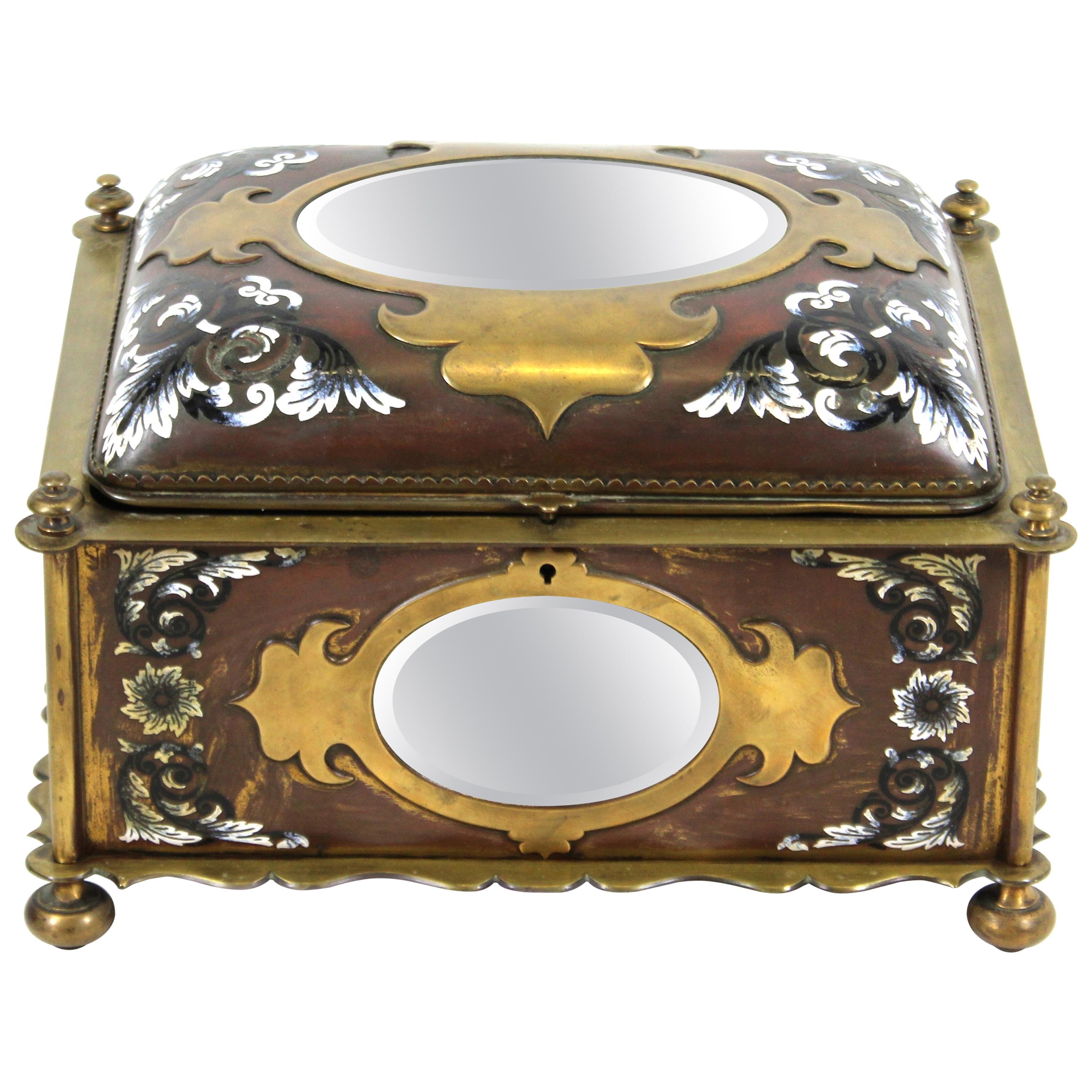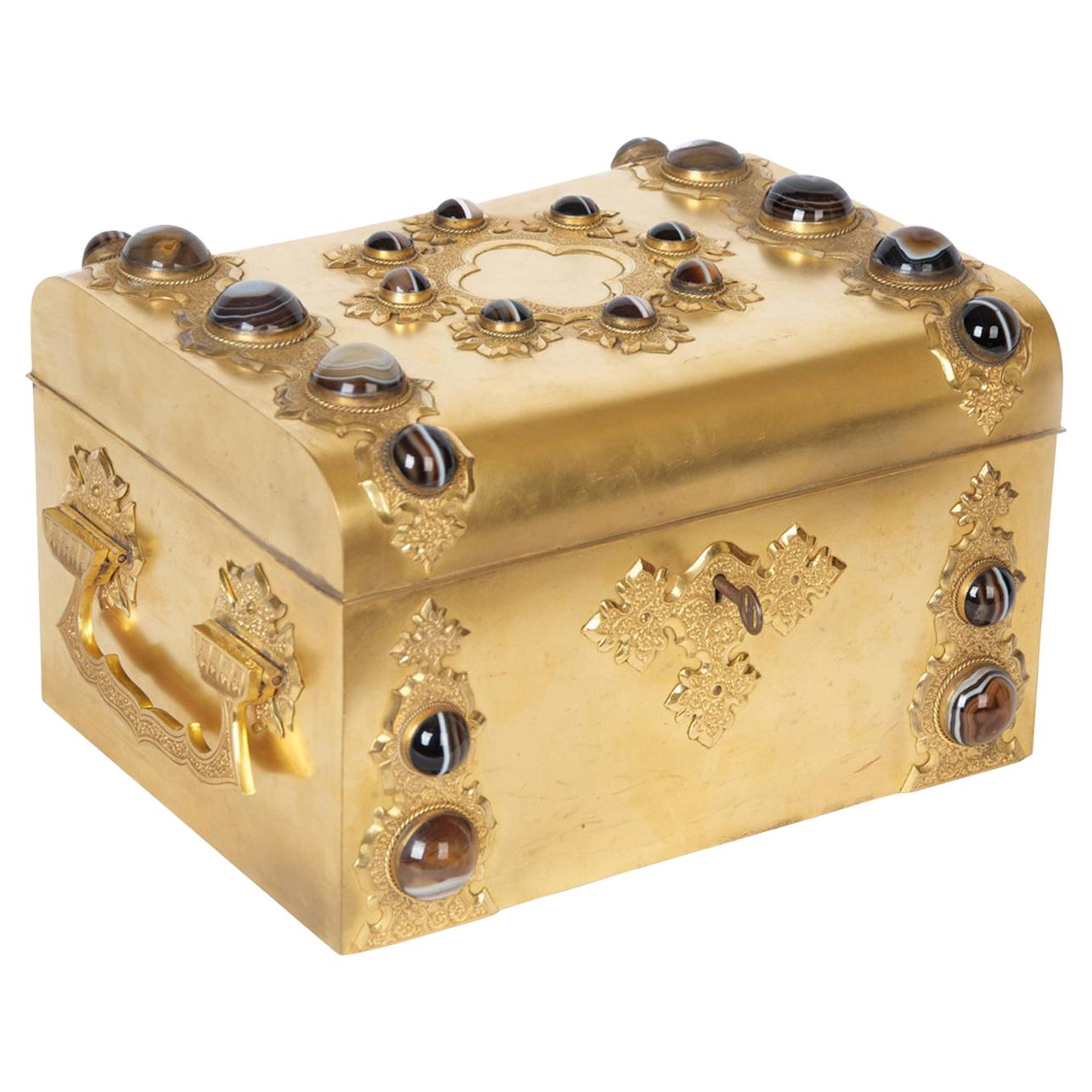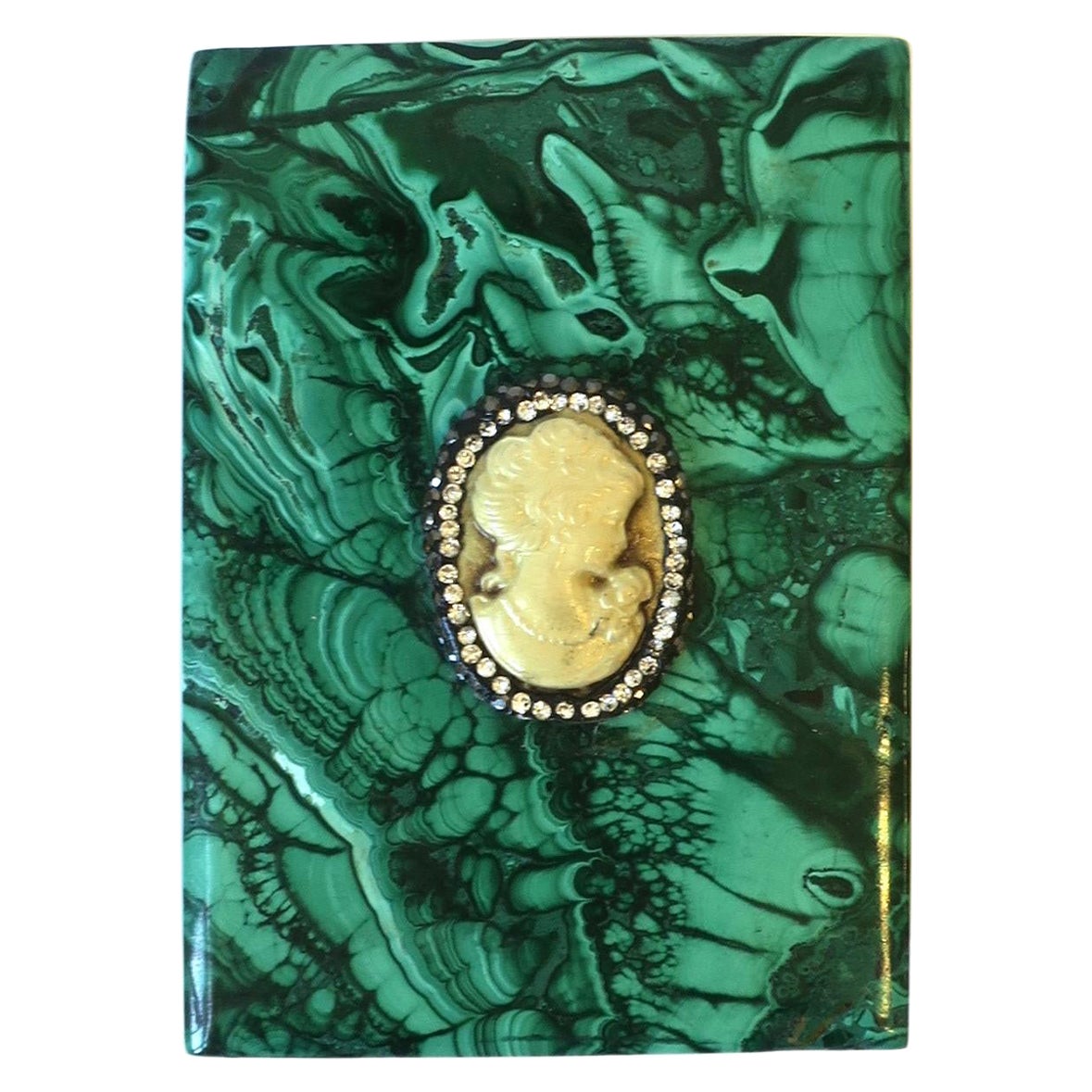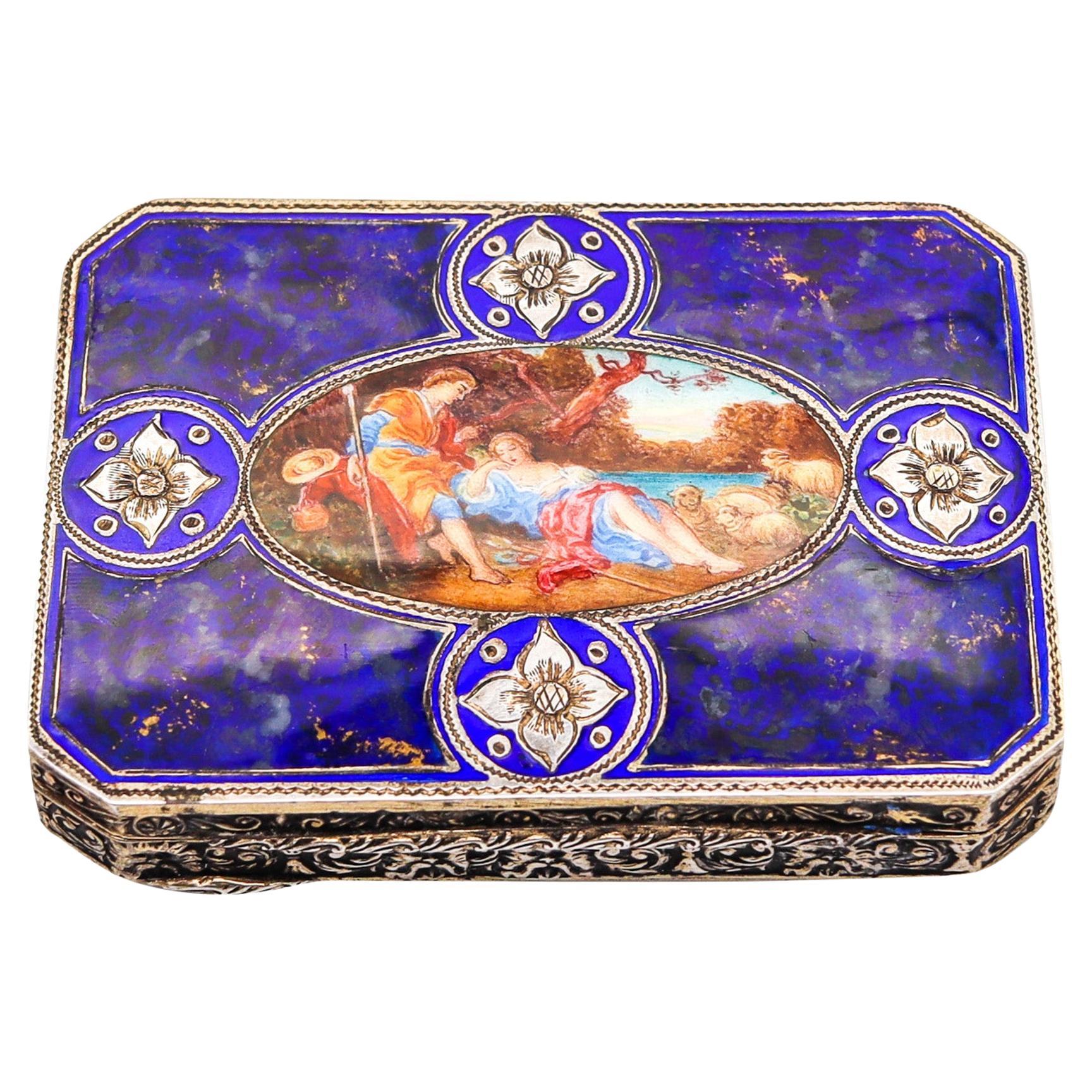Items Similar to A Renaissance Revival , Copper & Brass Mounted with Malachite Top, Jewelry Box
Want more images or videos?
Request additional images or videos from the seller
1 of 8
A Renaissance Revival , Copper & Brass Mounted with Malachite Top, Jewelry Box
About the Item
A Rare & Important Renaissance Revival
Copper & Brass Mounted with Malachite Top
Jewelry Box on Stand
Elkington & Co., England
Dated 1856
Elkington & Co; Birmingham, England; 1854 - 1883
With a rectangular top and velvet-lined interior, the sides mounted with plaques depicting a court scene and armorial plaques to each side, the stand with circular turned rods and stretchers
Height 39 in. Width 24 ½ in. Depth 17 1/2 in.
Museums:
Power House Museum, England
South Kensington Museum
Victoria & Albert Museum, England
National Maritime museum
Los Angeles County Museum of Art
Museum of Fine Arts, Boston
Glasgow Museum
Elkington and Co.
The electroplating firm of Elkington and Co is of interest to these pages for its sculptural work, on the small scale, and more importantly, for full-sized bronze statues. The company was set up by two cousins, George Richards Elkington (1801-1865) and Henry Elkington (1810-1852), who along with others, were experimenting with electroplating base metals during the 1830s. By 1840 they had patented their method in Britain and France, and bought out competing patent-holders, though they later licensed the process to various firms in England and abroad. The Elkington factory was in Newhall Street, Birmingham, and they also opened premises in London. In 1842 they took on a third partner, called Josiah Mason, and the firm became Messrs Elkington, Mason and Co.
Messrs Elkington have now in constant operation a stupendous machine constructed for the application of Magneto-Electric power, .. The armature of the machine, set in motion by a small steam-engine, revolves at 500 times in a minute, at a short distance from the poles of a series of 64 permanent magnets, arranged in a circle… sufficient to deposit 50 ounces of silver per hour. This machine has been in operation almost continually day and night for six months, with scarcely any perceptible variation in its energy.
By the time of the Great Exhibition they were the leading producer of plated wares,
'...celebrated electro-plate manufactures, a branch of industrial art which has made immense strides since the patent for the various processes of gilding and plating metals by the agency of electricity was granted to this firm in 1840. Messrs Elkington alone employ about 500 work-people in their establishment, and about 30 other British manufacturers have licences to use this process, which is also extensively adopted in foreign countries...'
The process for electrotyping (duplicating) to make statues was described thus:
'...to such perfection has the process been brought that not only are silver waistcoat-buttons and exquisite pieces of bijouterie produced, but a statue of bronze, as large as that of the Duke of Wellington at Hyde Park Corner, could be made of any thickness merely by electrical deposits... in fact the figures are hollow, and the entire substance employed is unalloyed bronze. To produce an electro-deposited figure, the model of it is formed, and from this a mould of fine clay or plaster is taken, the interior of the mould being thus an exact counterpart of the exterior of the model. On this being placed in a trough containing a solution of copper, the mould is rendered conducting, and the metal, gradually deposited inside the mould, becomes, in its turn, an exact counterpart of the original model. It will be understood from this brief description, that from the metal not shrinking in cooling, as in ordinary instances of casting, beauties and faults must alike be copied. The product in bronze is, in fact, an exact reproduction of the artist's conception, unalloyed by any mechanical imperfection almost necessarily attendant on the old process.'
Commenting on the success of the firm, writing shortly after the Exhibition, an art magazine wrote that
The show-rooms, which, astounding as it may seem, are longer than the body of the far-famed Birmingham Town-hall, though, of course, they are not to be compared in height with that splendid pile. … One division of these rooms is appropriated to bronzes: the Theseus reduced from the work of Phidias, among the Elgin Marbles, the Venus di Medici, Eve’s Hesitation by John Bell, with other works of modern art, a colossal head of Ocean from the Antique, with his sea-weed beard, and other marine appurtenances of the watery god...
Prominent is a bronze group, showing Tewdric the Great, King of Gwent and Glamorgan, who is shown wounded, yet urging on the pursuit of the flying Saxons, attended by his daughter, and an aged bard in the act of proclaiming the victory...' [I believe this work, on the left in the engraving above, is the one now in the National Museum of Wales, Cardiff.
Box INV. 20
- Dimensions:Height: 39 in (99.06 cm)Width: 24.5 in (62.23 cm)Depth: 17.5 in (44.45 cm)
- Style:Renaissance Revival (Of the Period)
- Place of Origin:
- Period:
- Date of Manufacture:Circa 1856
- Condition:Wear consistent with age and use.
- Seller Location:Sheffield, MA
- Reference Number:
About the Seller
4.8
Vetted Seller
These experienced sellers undergo a comprehensive evaluation by our team of in-house experts.
Established in 1980
1stDibs seller since 2017
45 sales on 1stDibs
- ShippingRetrieving quote...Ships From: Sheffield, MA
- Return PolicyA return for this item may be initiated within 7 days of delivery.
More From This SellerView All
- A Walnut Parquetry Sewing BoxLocated in Sheffield, MAThe square box with slant top fitted with pin cushion surrounded in parquetry of stained walnut, on toupie feetCategory
Antique 18th Century and Earlier German Boxes
- A Fine French Charles X Oval BoxLocated in Sheffield, MAA Leather box with two decanters insideCategory
Antique 19th Century French Boxes
- A Louis XV Ormolu mounted Tulipwood, Kingwood & Parquetry Collectors CabinetBy Jean-François OebenLocated in Sheffield, MAA Fine Louis XV Ormolu mounted Tulipwood, Kingwood & Parquetry Collectors Cabinet Mid 18th Century Attributed to Jean-François Oeben The shaped marble top over a shaped cabinet with tulipwood, kingwood & parquetry throughout, with tambour shutters revealing a re-fitted interior with 6 graduating drawers, all over four cariole legs ending in gilt bronze sabots. Height 41 in. Width 38 in. Depth 20 in. Jean-François Oeben, ébéniste du roi in 1754 and maître in circa 1761. Jean-François Oeben was a sub-tenant of charles-joseph boulle (1688–1751) in the galleries of the louvre from 1751, and in 1754 was granted lodgings at the gobelins and then at the arsenal in 1756. he was appointed ebéniste du roi in 1754 and was therefore able to work outside guild restrictions. he was a protégé of the marquise de pompadour, the marquis de marigny and the duc de choiseul. his identifiable works span less than ten years. his earliest pieces are in the louis xv style (e.g. small table, 1756–8; munich, residenzmus.), and he seems even to have completed some pieces started by jean-pierre latz (e.g. pair of corner cupboards...Category
Antique 18th Century and Earlier French Louis XV Cabinets
- A 16th/17th Century Style French Red Lacquered Small ChestLocated in Sheffield, MAAn Early & Rare French Red Lacquered
Leather Bound Wood & Iron Small Chest
Height 15 in. Depth 9 in. Width 13 in. ...CategoryAntique 18th Century and Earlier French Boxes
- Brass-Mounted Rosewood Campaign ArmchairLocated in Sheffield, MAA Brass-Mounted Rosewood Campaign Armchair Signed and Dated 1909 The turned collapsible frame with leather seat and footrest, the back stretcher wi...Category
Early 20th Century American Chaise Longues
- A Fine French Gilt Bronze & Malachite-Top Gueridon by Henry DassonBy Henry DassonLocated in Sheffield, MAA Fine French Gilt Bronze Gueridon with Malachite-Top By Henry Dasson , 1825-1896 Circa 1870’s The circular Malachite top on incurved supports terminating in rams’ heads and join...Category
Antique 19th Century French Gueridon
MaterialsBronze
You May Also Like
- French Renaissance Revival Champleve Enamel Jewelry Box with Oval Mirror InsertsLocated in New York, NYFrench Renaissance Revival champleve enamel jewelry box with oval beveled mirror inserts. Handmade in France during the mid-19th century. The ...Category
Antique Mid-19th Century French Renaissance Revival Decorative Boxes
MaterialsBronze, Enamel
- Renaissance Revival Gilt-Brass and Agate Dressing Table Box. French, c 1870Located in Brighton, West SussexA Renaissance Revival gilt-brass and agate mounted dressing table box. French, circa 1870. This fine box is applied with foliate engraved strap-work and side handles and finely po...Category
Antique Late 19th Century French Renaissance Revival Decorative Boxes
MaterialsAgate, Brass
- Antique 19th Century Brass Renaissance Revival Casket or Table BoxLocated in Philadelphia, PAA fine antique 19th Century brass casket or table box. In the Renaissance Revival style. With embossed brass sheet side panels, a domed lid, bail handle, and scroll & leaf work fee...Category
Antique 19th Century Renaissance Revival Decorative Boxes
MaterialsBrass
- Malachite Jewelry BoxLocated in New York, NYA very beautiful and substantial green Malachite decorative or jewelry box, circa late-20th century. This green Malachite box is hexagonal in shape with a white onyx marble star with gold gilt metal detail on top lid. Piece is hand-crafted. Box makes a great decorative or storage jewelry box to hold small items or jewelry such as necklaces (as demonstrated holding), rings, earring, cufflinks, etc., on a vanity, nightstand, dresser, desk, credenza, walk-in-closet, etc. Dimensions: 3.38" Depth x 4" Width. Purple box shown also available, search 1stDibs ref. #: LU1314228491742 Green malachite box with cameo, search ref. #: LU1314228492012 Small gold and malachite turtle...Category
Late 20th Century Modern Jewelry Boxes
MaterialsMalachite, Onyx
- Malachite Jewelry Box with Cameo DesignLocated in New York, NYA beautiful and substantial green Malachite decorative or jewelry box, circa late-20th century. Box is rectangular in shape with resin female cameo detail on top lid. Piece is beautifully hand-crafted. Piece makes a great decorative or storage jewelry box to hold small items or jewelry such as necklaces (as demonstrated), rings, earring, cufflinks, etc., on a vanity, nightstand, dresser, desk, credenza, walk-in-closet, etc. Dimensions: 2.25" Height x 2.38" Width x 3.32" Depth. Other boxes shown available separately; search 1stDibs ref. #s: Purple Charoite box...Category
Late 20th Century Neoclassical Jewelry Boxes
MaterialsMalachite
- Italian 1920 Renaissance Revival Enameled Octagonal Box in .800 SilverLocated in Miami, FLAn Italian enamelled snuff box. Colorful box, created in Italy, back in the 1920. It was crafted in an octagonal shape with neoclassical and renaissance Revival motifs in solid .8...Category
Vintage 1920s Italian Renaissance Revival Snuff Boxes and Tobacco Boxes
MaterialsSilver, Enamel





